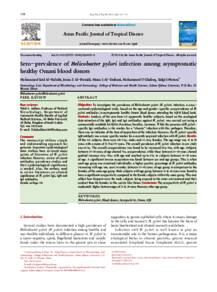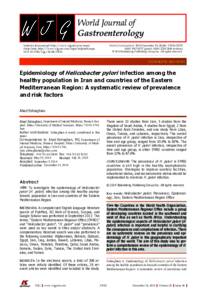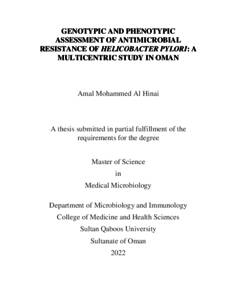Document
Sero-prevalence of Helicobacter pylori infection among asymptomatic healthy Omani blood donors.
Identifier
DOI: 10.1016/S2222-1808(13)60059-6
Contributors
Al-Busaidi, Juma Z., Author
Al-Daihaniyah, Muna S., Author
Shafeeq, Mohammed O., Author
Hasson, Sidgi S., Author
Publisher
Elsevier.
Gregorian
2013-04
Language
English
English abstract
Objective: To investigate the prevalence of Helicobacter pylori (H. pylori) infection, a cross-sectional epidemiological study, based on the age and gender-specific seroprevalence of H. pylori antibodies in asymptomatic healthy Omani blood donors attending the SQUH blood bank. Methods: Analysis of the sera from 133 apparently healthy subjects, based on the serological determination of the IgM, IgG and IgA antibodies against H. pylori, was carried out using a commercially available kit ELISA (NovaLisa, NovaTec, Germany). While the presence of H. pylori-specific IgG antibodies is the marker for a " "chronic. infection with this pathogen. Therefore, there was no indicator of the time of acquisition of the infection. However, the H. pylori-specific IgM antibody was a more specific marker for a recently acquired infection with H. pylori. Results: Of the 133 subjects, there were 100 (74. %) males and 33 (26. %) females. The age range was 15 to 50 years with a mean of 25.75. ±3.75 years. The overall prevalence of H. pylori infection in our study was 69.5. %. The overall seroprevalence was found to be increased 69. %-86. % with age. Subjects between 15. -20 years of age showed 71. % seroprevalence, while those between 21. -40 years showed gradual increase (63. %-70. %) with age and reached up to 87. % in subjects between 41. -50 years of age. A significant inverse association was found between sex and age groups. This is when each age group was examined individually; a higher positive percentage of H. pylori antibodies increasing with age was seen in males between 21. -40 years of age group in comparison to the females of the same age group. Male subjects with age group between 21 to 40 years were found to have a significant seropositivity compared to the female subjects within the same group. This may reflect how frequent were the male subjects being exposed to the outer environment and their conduct than the females in this society like Oman. Conclusions: The seropositivity of H. pylori is moderately higher between ages of 21 to 30 more than any other age group.
Member of
ISSN
2222-1808
Resource URL
Category
Journal articles



